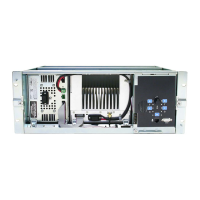168 Power Amplifier Fault Finding TB8100 Service Manual
© Tait Electronics Limited September 2006
8.13 Boost Regulator Board (12V PA Only)
These checks will verify that:
■ the DC output voltages are correct
■ Power Saving operation is correct.
Figure 8.15 on page 169 shows the recommended test equipment set-up.
Figure 8.16 on page 169 shows the location of the test points on the boost
regulator board. The circled numbers in the following instructions refer to
Figure 8.16.
Task 1 —
Check Output
Voltages
1. If you have not already done so, remove the cover as described in
“Power Amplifier Disassembly and Reassembly” on page 173.
2. Set up the test equipment as shown in Figure 8.15 and power up the
PA.
3. Check that the output voltages from the boost regulator board are as
listed below:
■ b output to reciter: 12VDC
1
(approximately)
■ c output to 6W board: 28VDC (approximately)
■ d output to 60W board: 28VDC (approximately)
If the voltages are correct, go to Task 2
. If they are incorrect, replace
the boost regulator board.
Task 2 —
Check Power Saving
Operation
This will check that the boost regulator board operates correctly in Power
Saving mode.
1. Short pins 1 and 2 of J1
e together and check that the output voltages
are as listed below:
■ b output to reciter: 12VDC
1
(approximately)
■ c output to 6W board: 0VDC
■ d output to 60W board: 12VDC
1
(approximately)
If the voltages are correct, go to Task 3
. If they are incorrect, replace
the boost regulator board.
Note Power Saving mode does not shut down the reciter output. It also
does not isolate the 60W board output from the input. Any volt-
age present on the input will appear on the output to the 60W
board.
Task 3 —
Check Alarms
1. Set up the test equipment as shown in “Recommended test equip-
ment set-up for initial checks - 28V PA” on page 134.
2. Run the Service Kit and connect to the base station.
1. 0.5V lower than the input voltage.

